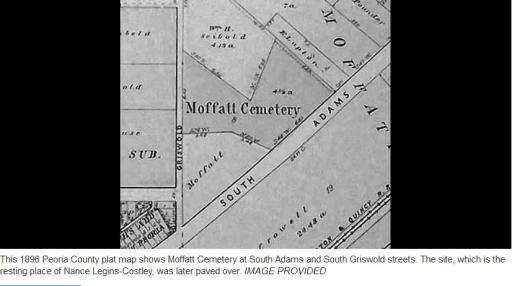Nance Legins-Costley of Illinois: First Black person freed by Lincoln
By: Phil Luciano (USA TODAY)



Phil LucianoJournal Star
PEORIA, Ill. - The name of Nance Legins-Costley could resonate amid the likes of Harriet Tubman, Frederick Douglass and other abolitionist figures.
But her story is hardly known. Not in Illinois, where - despite anti-slavery laws - she was born into bondage. Not in the city of Pekin, where - despite anti-Black attitudes - she became a beloved community figure. And certainly not in Peoria, where - despite her impressive life - she is buried in ignominy.
Perhaps her story is more subtle than those of high-profile abolitionist leaders, yet her fortitude was astounding. Barely a teen, she first stood up for her civil rights in a court of law that was stacked against Black people. Even amid legal defeats, she kept seeking the most basic of rights: freedom.

"She was a very impressive lady," says Carl Adams, a historian who has spent more than a quarter-century researching the struggles of Legins-Costley.
She eventually won her freedom, thanks to Abraham Lincoln. But her victory came in 1841, long before the attorney became the nation's president and more than 20 years before the Emancipation Proclamation.
Thus, Legins-Costley became the first Black person freed from bondage by Lincoln, to eventually be followed by 4 million others. Moreover, Adams and other historians say, the case pushed a theretofore ambivalent Lincoln toward an anti-slavery stance.
"This was the first time Abraham Lincoln first gave serious thought to these conditions of slavery," Adams says.
And for all that, not only is her story relatively unknown - Legins-Costley's final resting place is marked with no honor. Rather, it's not marked at all. Decades ago, her graveyard in Peoria was paved over with asphalt.
Legins-Costley lies somewhere amid a muffler shop, union hall, auto garage and other commercial buildings, mostly forgotten by the march of progress, under a tombstone of asphalt.
A free state's slaves
Illinois, the Land of Lincoln, was once the land of slavery.
After losing the Revolutionary War, Britain ceded a vast chunk of land - including what would become Illinois - to the United States. Established in 1787, the Northwest Territory forbade slavery per the federal Northwest Ordinance. When Illinois became a state in 1818, its constitution prohibited slavery.
But legislation is one thing. Reality is another. And slavery already had traction in Illinois.
In 1752, when France ruled the area, Black slaves were held by 40% of Illinois households, according to The Randolph Society, a historical organization in Randolph County in southern Illinois.
Despite the institution of the Northwest Ordinance, the territorial government did not enforce the slavery prohibition, nor did the state immediately after joining the union in 1818. What were known as "French slaves," descendants of the area's original slaves during the 1700s, were kept in subjugation into the mid-19th century. Meanwhile, slaves could legally be brought to Illinois from slave states for one year (but renewable) work contracts.
The territory and state also permitted a system of indentured servitude. The lengths of servitude varied by age but could extend as long as 99 years - essentially, a lifetime. Though the law implied the need for consent by the servant, the system was essentially slavery by another name. Indeed, indentured-servitude contracts (and thus the services of the servant) could be sold just like any sort of property, and without any consent necessary.
Amid this era of bondage came the arrival of a baby who would grow up to be Nance Legins-Costley.
To a large degree, her story remained unknown until the mid-1990s, when Adams first noticed a mention of her life. Adams, who recently lived in North Pekin, gradually unpeeled layers of her life, a process he continues today.
"It is a short, simple story compared to most Lincoln books, but it has made a bigger impact than I ever imagined," says Adams, who in 2016 published "Nance: Trials of the First Slave Freed by Abraham Lincoln."

Nance was born in 1813 in Kaskaskia, which briefly served as Illinois' first capital. She likely was the daughter of Randall and Anachy Legins, who had been bought as indentured servants (along with two others) by Col. Tom Cox for $770.
By laws of the time, Nance could be held (or sold) as an indentured servant until age 28.
By 1820, Nance, 7, and sister Dice, 5, were already working at Cox's Columbia Hotel. Though the state capital already had moved to Vandalia, boarders - including businessmen and other bigwig travelers - routinely would discuss issues of the day, including slavery.
And Nance, though illiterate for a lack of schooling, listened intently.
A Black girl's boldness
In 1822, the Cox household (including indentured servants) relocated to Springfield, which would not become the state capital until 1839. In 1827, with Cox awash in debt thanks to bad land speculation fueled by drunkenness, a Sangamon County court ordered the sale of all of his possessions, including his indentured servants.
In what amounted to the only legal slave auction in Illinois' history, Dice was sold for $150 to a man named Taylor, while Nance was sold for a dollar more to Nathan Cromwell.
Dice went quietly. Nance did not. "She did not want to leave the only household she ever had," says historian Adams.
Nance resisted relocation with Cromwell, her stance remarkable for a Black girl not yet 14 years old. In return for her boldness, she was locked inside a windowless salt house - essentially solitary confinement - for a week. After that, Cromwell forcibly took her from Springfield to his home in Sangamotown.
But Nance still had plenty of fight left.
Despite the court-ordered sale, Cox kept filing petitions in an attempt to keep hold of his possessions, including his indentured servants. During a hearing in Sangamon County Court, Nance testified that (despite auction records otherwise) she had given no consent to the sale of any contract: "It is not true that I, Nance, voluntarily and of my own free will, agreed to go with Cromwell to his house in Sangamotown, nor is it true I still live with Cromwell by my own choice."
The case went to the Illinois Supreme Court. But justices ignored her plea and ruled against Cox: Her consent made no difference, as the sale had been legal.
Still, Cox kept up the fight with repeated appeals regarding Nance and the court-forced sale.
"Thomas Cox went to the Illinois Supreme Court more than anyone in history," Adams says with a chuckle. "And he lost every time."
So, Nance remained with Cromwell. In 1829, he and his wife, Ann Eliza, took Nance along as they moved to Tazewell County, where they helped found a new city. Ann Eliza Cromwell gave the town its name, Pekin - the French spelling of the Chinese city Peking, thought at the time to be directly on the opposite end of the globe.
But after his wife died a couple of years later, Nathan Cromwell decided in 1836 to move to Texas, hoping to strike it rich in land speculation. Nance, 23, objected to moving again: She already had one baby, with another on the way.
As Nance resisted a move to Texas, Cromwell had his own reasons to leave her behind. At 65 years old, such a companion could spark scandal along the way to Texas, Adams says.
"Cromwell didn't want to take a single, pregnant Black woman with him because it would attract attention," Adams says.
A bargain for freedom
Cromwell approached a merchant named David Bailey, a former business partner, to suggest Nance stay behind and work at his store. Bailey was amenable for two reasons, moral and pragmatic.
Bailey was an abolitionist whose father-in-law had been a conductor on the Underground Railroad. He thought helping Nance would be a step toward breaking her indentured servitude.
From a former business deal, Bailey already owed $400 to Cromwell, Adams says. Cromwell offered to essentially cancel that debt if Bailey were to take in Nance for $400. Bailey agreed to sign a promissory note for that amount, but only upon the condition that Cromwell produce documentation of her indentured servitude.
But Cromwell left for Texas without providing the paperwork. In St. Louis, far from his destination, he died. Immediately, Nance declared herself free, left Bailey's service and lived independently.
On Oct. 15, 1840, in Pekin, she married a free Black man named Benjamin Costley, thus becoming Nance Legins-Costley. In addition to two girls, Amanda and Eliza Jane, the household would include a son in 1841: William Henry Costley.
But Nance wasn't yet free in the eyes of the law.
A relative of Cromwell went to court in Tazewell County, suing for Bailey's $400 in the deal. Bailey claimed he owed no money: The sale had been nullified by the lack of the agreed-upon indentured servitude documents. When a judge disagreed and deemed Nance a possession, Bailey took the case to the Illinois Supreme Court in Springfield.
For legal help, Bailey contacted an attorney friend there with whom he had served in the Black Hawk War: Abraham Lincoln.

Lincoln, 32, was serving his fourth term in the state Legislature. His stance on slavery was ambivalent at the time, Adams says.
Lincoln was wary of extreme abolitionists, some of whom would burn flags and decry the constitution, Adams says. Lincoln did not want to be seen as an anarchist.
"Burning flags did not go over well with veterans and others," Adams says.
Still, in principle, Lincoln opposed slavery. In addition to wanting to help his friend Bailey, he saw merit in the case, especially as it related to Legins-Costley's long fight for freedom. She and Lincoln would discuss matters of the case, which in time would push him toward a firm anti-slavery stance.
"It helped solidify Lincoln's ideas about slavery," Adams says.
On July 9, 1841, Lincoln appeared before the state's high court, his arguments leaning heavily on anti-slavery language of the Northwest Ordinance and the Illinois Constitution. Justices agreed and ruled in favor of Bailey and Lincoln: "It is a presumption of law, in the State of Illinois, that every person is free, without regard to color. ... The sale of a free person is illegal."
Legins-Costley was freed from indentured servitude, as were her children. In that way, infant son William Costley was the first male freed from bondage by Abraham Lincoln.
Legins-Costley and her husband remained in Pekin, where they would have five more children. Though bereft of an education herself, she made sure all of them attended school.
The family lived in a log cabin along the Illinois River. Even before the high court's ruling, she had become a valued, contributing member of the Pekin community. In the mid-1830s, Pekin got walloped by a triple whammy of cholera, malaria and scarlet fever. One of the first victims was the lone doctor, leaving medical care mostly to townsfolk. Nance, despite no medical training, rose to the occasion and helped care for the ailing, with little regard for her own safety.
"Nance was always willing to help," Adams said.
She enjoyed that reputation the rest of her days in Pekin, says Jared Olar, a Pekin Public Library assistant who has written multiple articles about Legins-Costley. Considering the color of her skin, her good standing was especially noteworthy.
"Her reputation in Pekin was only one of praise," Olar says. "Considering the prejudice against Black (people) there, they had respect for her."
The 1870 Pekin city directory recognized Legins-Costley with an entry among notable citizens: "With the arrival of Major Cromwell ... came a slave. That slave still lives in Pekin and is now known, as she has been known for nearly half a century ... (as) 'Black Nancy.' She came here a chattel. ... But she has outlived the age of barbarism, and now, in her still vigorous old age, she sees her race disenthralled; the chains that bound them forever broken, their equality before the law everywhere recognized and her children enjoying the elective franchise."
The family served at the forefront of another key event in the fight for racial equality.
William Costley, at about age 23, left Pekin in 1864 to join the 29th Illinois Regiment of U.S. Colored Troops, the only Black regiment from Illinois and the largest of all the state's regiments. After battles elsewhere, the regiment was sent to Texas in June 1865. Though Confederate Gen. Robert E. Lee had surrendered April 9, Union troops never had invaded Texas, leaving 250,000 slaves there still unfreed.
On June 19, with Costley and his regiment among federal troops sent into Galveston, Gen. Gordon Granger announced, "The people of Texas are informed that, in accordance with a proclamation from the executive of the United States, all slaves are free."
A celebration followed, one that continues annually today on what is known as Juneteenth.
What to know about Juneteenth: Holiday marking Emancipation Proclamation takes on extra importance in 2020
After the war, William Costley returned to Pekin. There, in 1870, he was at the center of another racially connected court case. On a Pekin street, a white resident (and convicted rapist) was brutally assaulting a woman. When the man refused Costley's demand to stop the attack, Costley shot him dead. Though charged with murder, Costley was acquitted by an all-white jury, which called his actions "justifiable homicide by protecting a woman in need."
He left the area for Iowa before moving to Minneapolis in the 1880s. In 1888, while still suffering shoulder pain from a shrapnel injury during the war, he was admitted to Rochester State Hospital in Rochester, Minn. He died there that same year.
In 1883, Legins-Costley's husband, Ben Costley, died of unspecified injuries. After that, Legins-Costley went to live with daughter Amanda and her husband in Peoria. She died in Peoria at age 79 on April 6, 1892.

A tombstone of asphalt
As historian Adams discovered more and more about the story of Nance Legins-Costley, there was speculation about her burial. The mystery headed toward a solution in 2017, when amateur researcher Bob Hoffer of Peoria found the site of Moffatt Cemetery. While tracing family roots, he delved into records showing that the graveyard had thrived in the late 19th Century. But by 1905, the city shuttered the cemetery, possibly for overcrowding.

Abandoned, the site fell into disrepair and became almost unrecognizable by the 1930s. Later, the city announced plans to develop the area, promising to move the graves and remains to other cemeteries.
"That was far from the truth," Hoffer says. "It was absolutely criminal what happened."
His research shows that maybe 100 graves were relocated. The rest - as many as 3,000 graves, including those of 48 Union soldiers - were covered by asphalt. At a ceremony there in 2017, Hoffer and others placed a sign on a chain-link fence to recognize the names of the soldiers buried there.

Noticing his work was Deb Clendenen of Pekin, a retired nurse and genealogical researcher. Reviewing those records, she discovered that Nance Legins-Costley had been buried in Moffatt Cemetery. She declined comment for this story. But Hoffer says no records have been found to show that Nance Legins-Costley was among the city's few grave relocations. Her husband also is likely buried there.
These days, Hoffer, Adams and others are working on plans to create a permanent marker to recognize Moffatt Cemetery. In part, it will honor Nance Legins-Costley.
Adams continues with research, in part to seek descendants of Nance Legins-Costley. Now 69 and living in Maryland, he still marvels at how long history seemed to bypass her story.
He says with a laugh, "How was this missed?"
Follow Phil Luciano of the Peoria Journal Star on Twitter: @LucianoPhil

 Article is LOCKED by moderator [Split Personality]
Article is LOCKED by moderator [Split Personality]




Interesting woman, history and Lincoln's role in their lives
What an amazing story and woman. I'd never heard of her before she surely deserves to be known by the American public.
How ironic that Lincoln fought in the Black Hawk war and then freed her and millions of other black slaves. The irony is tragic.
Imagine, as many as 3,000 people buried under a parking lot.
SMH